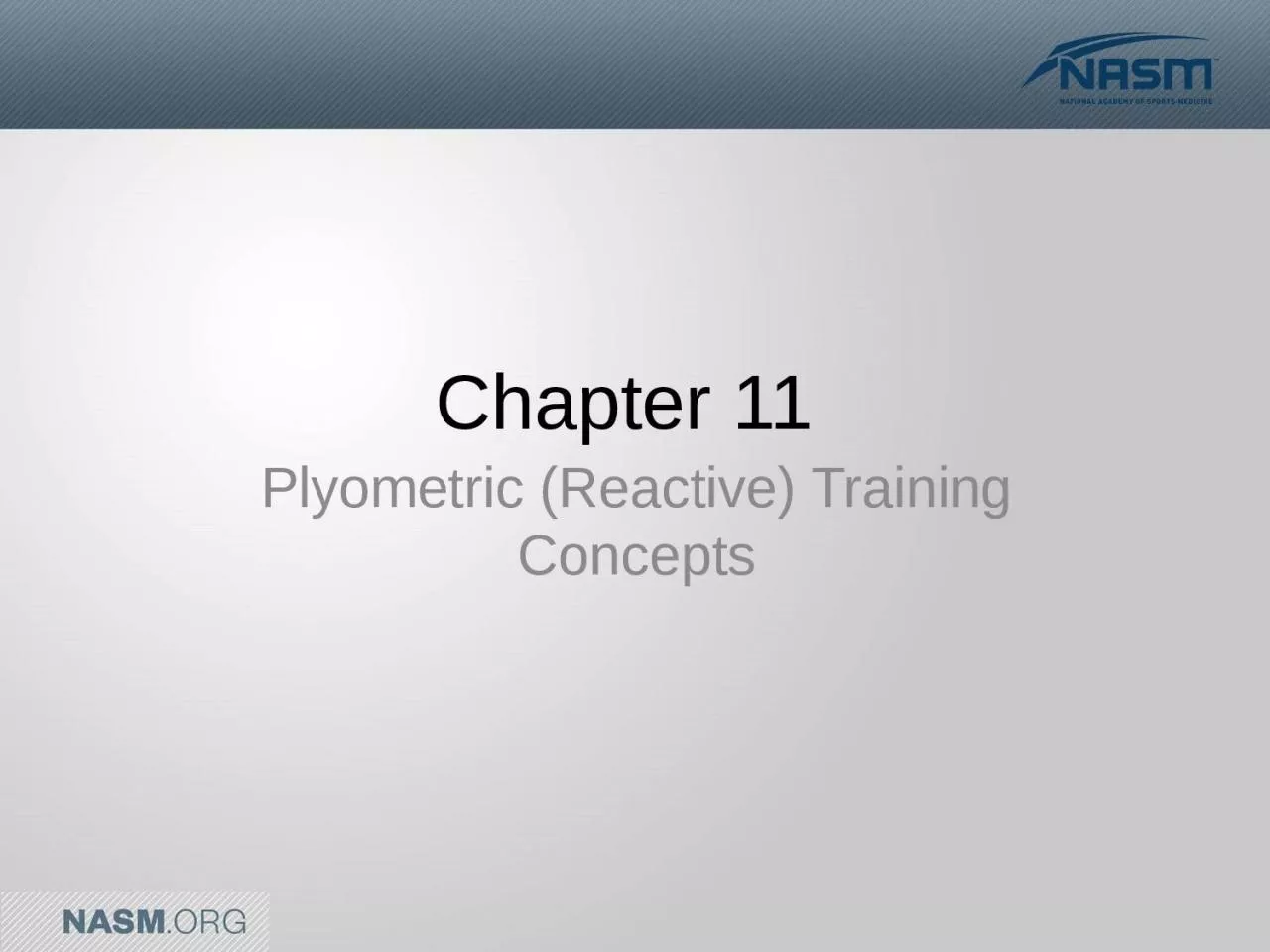

Purpose To provide the fitness professional with a fundamental level of knowledge regarding the use of plyometric training concepts To allow the fitness professional to select and administer the appropriate plyometric training protocol for all clients ID: 1011844
Download Presentation The PPT/PDF document "Chapter 11 Plyometric (Reactive) Traini..." is the property of its rightful owner. Permission is granted to download and print the materials on this web site for personal, non-commercial use only, and to display it on your personal computer provided you do not modify the materials and that you retain all copyright notices contained in the materials. By downloading content from our website, you accept the terms of this agreement.
1. Chapter 11 Plyometric (Reactive) Training Concepts
2. PurposeTo provide the fitness professional with a fundamental level of knowledge regarding the use of plyometric training concepts.To allow the fitness professional to select and administer the appropriate plyometric training protocol for all clients.
3. ObjectivesAfter this presentation, the participant will be able to:Define plyometric (reactive) training and describe its uses. Discuss the importance of plyometric training. Design a plyometric training program for clients in any level of training.Perform and instruct various plyometric training exercises.
4. Concepts in Plyometric TrainingEnhanced performance during functional activities emphasizes the ability of muscles to exert maximal force output in a minimal amount of time (also known as rate of force production).
5. Concepts in Plyometric TrainingQuick, powerful movement involving an eccentric muscle action followed immediately by an explosive concentric contraction. Provides the ability to train specific movement patterns in a biomechanically correct manner at a more functionally appropriate speed.Success in most functional activities depends on the speed at which muscular force is generated.
6. Phases of Plyometric ExerciseThere are three distinct phases involved in plyometric training:Eccentric (loading) phaseAmortization (transition) phaseConcentric (unloading) phase
7. Importance of Plyometric TrainingPlyometric exercises enhance the excitability, sensitivity, and reactivity of the neuromuscular system and increase the rate of force production (power), motor unit recruitment, firing frequency (rate coding), and motor unit synchronization.All movement patterns that occur during functional activities involve a series of repetitive stretch-shortening cycles (eccentric and concentric contractions).
8. Designing a Plyometric Training Program Adequate functional total body strength, core strength, and balance are essential before beginning plyometric training.The fitness professional must follow specific program guidelines, proper exercise selection criteria, and detailed program variables.
9. Exercise SelectionExercises Must BeSafeDone with supportive shoesPerformed on a proper training surfaceGrass fieldBasketball courtTartan track surfaceRubber track surfaceProgressive
10. VariablesPlanes of MotionSagittalFrontalTransverseType of ImplementsTapeConesBoxesAmplitude of Movement
11. Levels of Plyometric TrainingThere are three levels of training within NASM’s OPT™ model:StabilizationStrengthPower
12. Plyometric-Stabilization ExercisesExercises involve little joint motion. Designed to establish optimum landing mechanics, postural alignment, and reactive neuromuscular efficiency.
13. Plyometric-Strength ExercisesExercises involve more dynamic eccentric and concentric movement through a full range of motion.
14. Plyometric-Power ExercisesExercises involve the entire muscle action spectrum and contraction velocity spectrum during integrated functional movements.Performed as fast and as explosively as possible.
15. Implementing a Plyometric ProgramStabilization Level (Phase 1)Select reactive stabilization exercisesStrength Level (Phases 2–4)Select reactive strength exercisesPower Level (Phase 5)Select reactive power exercises
16. Program Design
17. SummaryA plyometric training program is designed to enhance neuromuscular efficiency, increase rate of force production, and improve functional eccentric strength. A client must exhibit proper levels of total body strength, core strength, and balance before progressing into plyometric training. A proper plyometric-training program follows the same systematic progression as the OPT™ model: stabilization, strength, and power.